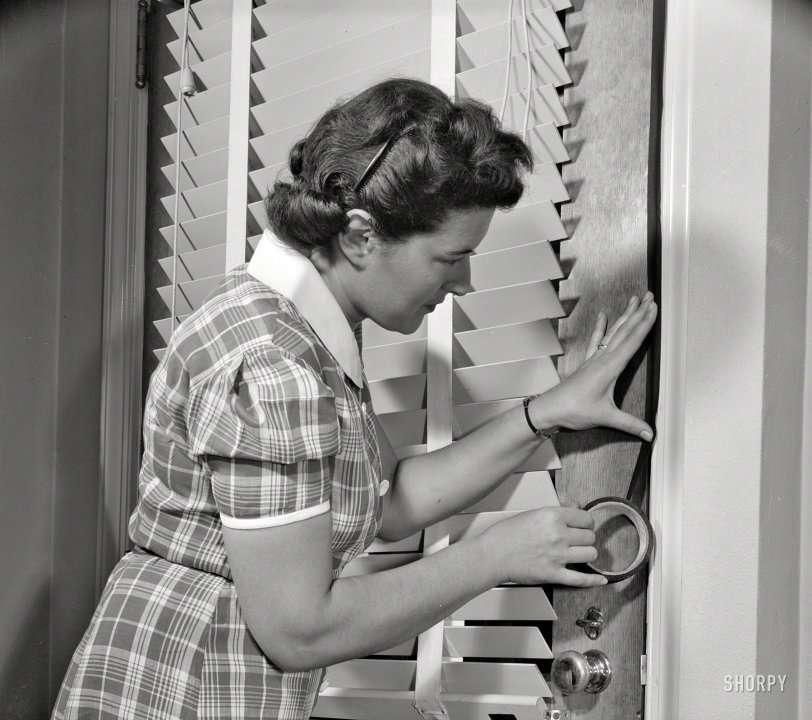


Framed or unframed, desk size to sofa size, printed by us in Arizona and Alabama since 2007. Explore now.
Shorpy is funded by you. Patreon contributors get an ad-free experience.
Learn more.

- Texas Flyer wanted
- Just a Year Too Soon
- WWII -- Replacing men with women at the railroad crossing.
- Yes, Icing
- You kids drive me nuts!
- NOT An Easy Job
- I wonder
- Just add window boxes
- Icing Platform?
- Indiana Harbor Belt abides
- Freezing haze
- Corrections (for those who care)
- C&NW at Nelson
- Fallen Flags
- A dangerous job made worse
- Water Stop
- Passenger trains have right of way over freights?
- Coal
- Never ceases to amaze me.
- Still chuggin' (in model form)
- Great shot
- Westerly Breeze
- For the men, a trapeze
- Tickled
- Sense of loneliness ...
- 2 cents
- Charm City
- What an Outrage
- Brighton Park
- Catenary Supports
Print Emporium
Darken My Door: 1943

Circa 1943. "Civilian defense in the United States. Blackout measures." For the especially conscientious. Office of War Information. View full size.
Sitting Pretty On The Sink
One of my first memories was an air raid drill about 1943.
I was sitting on the drainboard of our kitchen sink (pronunced zink in my neck of the woods) as Mom gave me a bath while in the far distance was the wail of the sirens and in the near distance was the scurrying of my father and older sister making sure all lights were out.
My next memory came a few years later where I can see myself riding a tricycle on Elmora Avenue shouting, "The war is over! The war is over!"
I didn't have a clue as to what war was over and was probably hoping the sirens would sing tonight and make everybody turn off the lights.
Real deal
The threat from bombers may have been theoretical, but German U-boats did sink a lot of merchant ships off the American coast after Pearl Harbor, many of them silhouetted against the lights of the eastern seaboard.
Blackouts on L.I.
Although only five years old, I remember very well the blackouts we had on Long Island. The roll-up shades on the windows were a very dark and opaque green, and if you heard the siren, the lights were turned down, if there was any light showing outside, you could expect a knock on the door from the Air Raid Warden. Dad had put black tape on the upper half of the auto headlights. All of this no doubt due to the close proximity of the defense plants scattered all over the island. Grumman Aircraft, Republic Aviation, Mitchel Field, Liberty Aircraft, The Brooklyn Navy yard, and all their supporting manufactories, to name just a few.
Re: Heavy Drapes
I'm not quite old enough to remember the War, but the house we moved into on New York's Long island in the late 40s had opaque dark green roller-type window shades left over from the blackout.
Block Warden
During the war my Grandfather was a block warden in Berkeley Ca. Various neighborhoods and areas had people assigned to check for any stray light leaks at night.
Counterpoductive
How do you use that door as a door once you have taped it shut? Re-tape it every time after you opened and closed it again? The Sticky Tape Administration must have provided a major supply for each and every household.
The way I have seen it in movies (European theatre, Axis side), tape was not used to seal doors and windows around the edges. After all, they were resting in frames anyway. Light has a hard time to go around a corner.
However, they did use tape (if available) to put in on the panes, to make the glass more resistent against airblasts, at least if the bombs went off at some distance. And even that was only an X on each pane.
For blackout you used heavy drapes (if available), and otherwise you would put blankets over your windows during the night. Less frequently used windows (such as in basements) would have had something permanently nailed on, or else have been painted over.
Another door?
I really hope she has another way out of the house in case of an emergency.
That black electrical tape is going to ruin the paint, her husband is gonna be tee'd off.
Whew!
Thanks for the explanation! I thought this was the next step in the ongoing card party those three ladies are having.
Don't worry
Those venetian blinds are pointing down, no Axis bombers will see that.
























On Shorpy:
Today’s Top 5